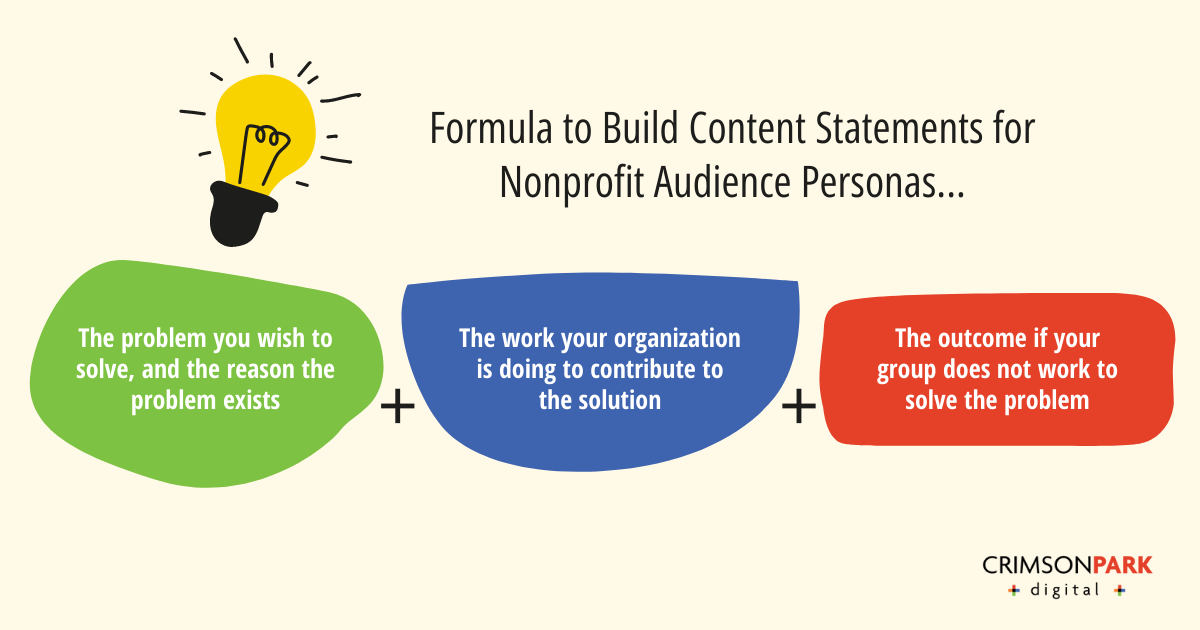Developing a Nonprofit Content Marketing Strategy
4 Steps to Develop a Nonprofit Content Marketing Strategy
Though developing a nonprofit content marketing strategy can seem like a daunting or tedious task, the benefits of what it provides are usually worth the time commitment. For nonprofits, in particular, developing a content marketing strategy could be beneficial if it:
- Helps people solve a problem they may be seeking information about
- Teaches people something new
- Inspires people to make a purchase, donation, or volunteer their time
Because a nonprofit relies on external financial donations and volunteer “people power”, a strong content strategy creates a vital driving force for attaining resources.
Step 1: Defining the audience for your nonprofit
To develop a strategy that converts for your nonprofit organization, start by determining your audience(s). This should be made up of stakeholders such as donors, volunteers, members, participants, and anyone else you rely on for your nonprofit to function. Common stakeholders for a nonprofit include:
- Employees (paid)
- Volunteers (unpaid), can include board members and people who assist at events or in other ways that keep the organization running.
- Members (paying or honorary)
- Beneficiaries – those who receive the services or benefits your organization provides.
- Donors – grant givers, foundations, state or federal agencies that provide funding, and high-profile individuals all fall into this category.
- The local community, supporting local nonprofit organizations via community activities
Each stakeholder relevant to your organization should have its own profile – or ‘persona’ – that defines basic demographics, the ways your organization interacts with the stakeholder, questions this group may have about your organization, reservations they may have with engaging with your organization, and reasons these specific stakeholders should be involved with your organization. Outlining details in each of these sections will make simple work of developing a specific content strategy for each group.
Step 2: Crafting nonprofit content purpose and positioning
Developing content positioning and themes for each stakeholder group can be as simple as writing a short purpose statement for your content. Here’s an easy formula to follow to build your content statements for each group:
Step 3: Developing your nonprofit content’s tone
Your organization’s content marketing strategy should include a clearly-defined tone with examples for each audience you intend to reach. Having an established tone, which may differ greatly for each segment, will create a consistent content presence across the channels your organization distributes information through.
For example, content developed to generate buzz around volunteering may require an uplifting tone that emphasizes the way volunteers make a difference. Content delivered to prospective donors may take on a more serious tone by discussing the problems that led to why your organization exists and what will happen if your organization is unable to meet the needs of the group it is attempting to benefit.
QUICK TIP: Most nonprofit organizations have their purpose and mission statements clearly defined; it’s how you earn grants and generate support. The mission, or the organization’s reason for existing provides the why and the purpose, or the way you implement your mission, provides the how. To begin building your content marketing strategy, define the who – the audience you want to reach – and you now have the building blocks of your strategy.
Step 4: Create specific content goals for nonprofits
For nonprofit organizations, content marketing goals for all defined audiences could include raising awareness, increasing engagement, and encouraging action. Once the goals of your content have been written out, the channels on which you distribute the content can be selected. One benefit of content marketing is the ability to distribute the same or similar content across multiple channels.
Here are some examples of goals and channel strategies that may work for your organization:
- Build awareness
Focus on your Search Engine Optimization (SEO) strategy, as part of content marketing. SEO refers to the techniques that lead to a higher ranking on the search engine results page, and therefore, the number of website visitors.
Your website should contain plenty of relevant content and keywords across its pages, so search engines can easily analyze what the website is about. The bottom line is that people will not be aware of your organization’s existence if it doesn’t serve up solutions and content to related problems or questions.
- Increase engagement
Create content for your social media channels that spark conversations, or ask your audience to participate in some way. You may try sharing fast facts that your audience would be inclined to share or position a post as a question requesting answers in the comments.
A collaboration with another local group or company and relevant contests could increase your audience and incentivize engagement on specific posts.
- Encourage action
Craft blog posts that detail the problems that led to your organization’s founding, write up volunteer testimonials or case studies, and send e-newsletters to solicit volunteers.
Content from a blog post can be easily shortened and shared on social media channels and distributed to your email lists. Case studies and volunteer testimonials add additional keyword value to your website and boost SEO ranking.
After these four steps have been completed by your organization, the last thing to do is measure the success of the content pieces you distribute and adjust accordingly. For most organizations, marketing strategies will change over time based on what gets results, so stay flexible and keep trying. The results of successful content marketing campaigns could be exactly what your organization needs to achieve growth.
Interested in getting started but don’t have the internal team to execute content marketing? Contact us today to learn how our content strategists can help!
Frequently Asked Questions
How do nonprofit organizations create content?
Nonprofit organizations create content through search engine optimization techniques, informative and educational social media posts, encouraging user-generated content (UGC), sending e-newsletters, and sharing relevant case studies on their website.
How do I market my nonprofit on social media?
Encouraging action and spreading awareness of the problems your nonprofit seeks to address can help market your nonprofit organization on social media.
What is the most effective content type for nonprofits?
The most effective type of content for nonprofits varies depending on the specific campaign goals of the organization.


